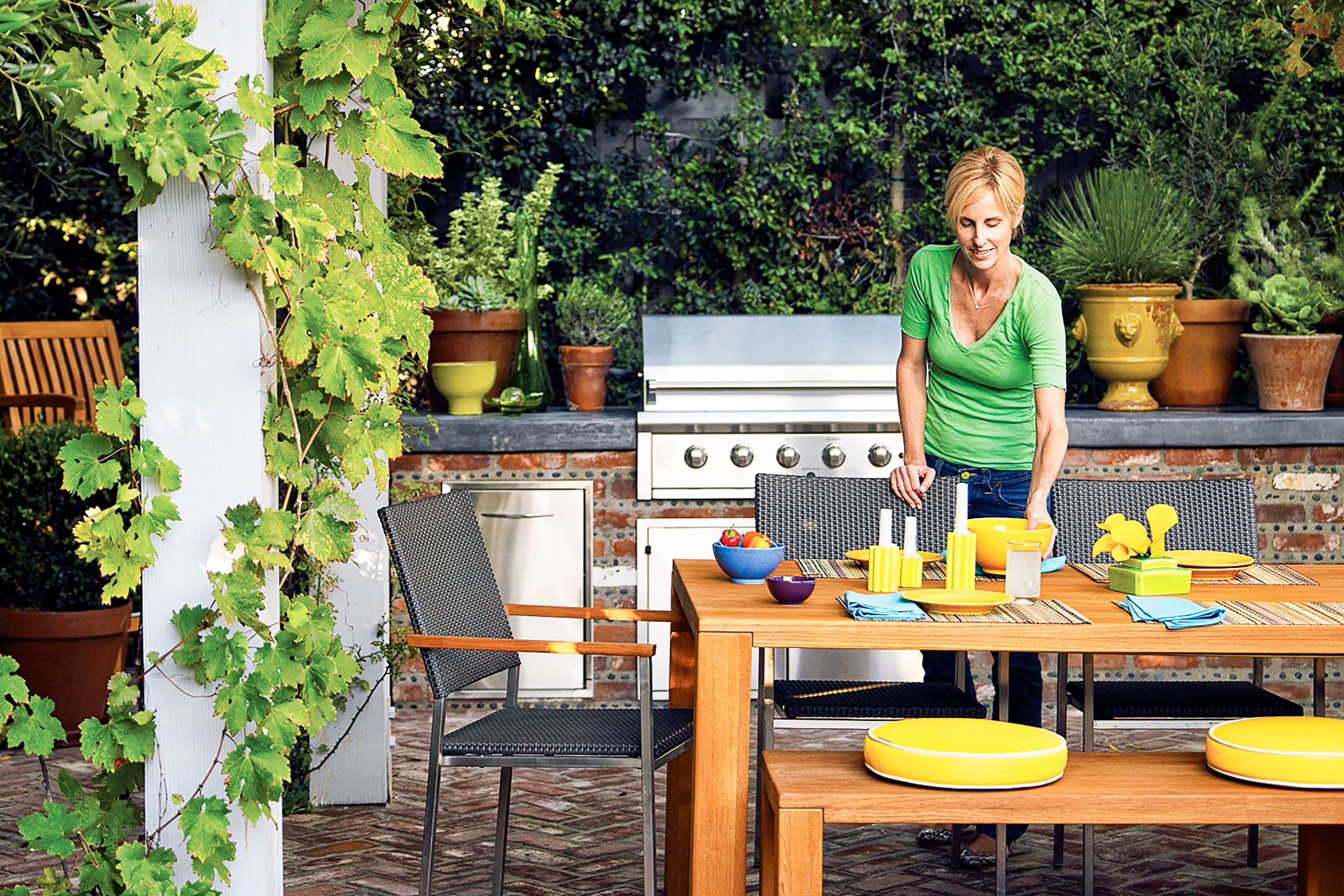If you spend a lot of time in your yard, an outdoor kitchen may be just the thing you need to enhance your alfresco lifestyle. An outdoor kitchen expands your living space, makes it easier for you to entertain, and eliminates crumbs on your floor. But before you decide to install one, there are several things to consider. In this article, we’ll cover everything you need to know about outdoor kitchens, whether you’re taking the do-it-yourself (DIY) approach, building one on a budget, or hiring a pro to do the job.
Types of Outdoor Kitchens
Outdoor kitchens can be as simple as a storage cabinet for cooking gear or as ambitious as a full kitchen with grill, refrigerator, sink, and eating area. Either way, your yard will gain an outside “room” that’s a natural gathering spot. Here are three outdoor kitchen types you may consider:
Movable
A kitchen on wheels works well in smaller spaces so that you can move it when you need the extra area to kick the ball around or mow the lawn. Start with a portable charcoal or gas grill fitted with heavy cast-iron or stainless-steel grates and an easy-to-clean grease trap. For storage and counter space, add a rolling cart with shelves. To ensure that each meal is grilled to perfection, buy a clip-on grill light.
Prefab
A prefab outdoor kitchen is an all-in-one option for folks with more square footage and cash to spend. The basic setup typically includes a stucco-clad 5-foot island with tile counter, drop-in gas grill, and access doors for a propane tank. Extras, including granite counters, a refrigerator, and LED lighting, are ordered a la carte. DIYers can get cooking with a prefab island on delivery day.
Custom
A custom outdoor kitchen offers integrated appliances, storage, and counter space, as well as the most flexibility in terms of matching the kitchen’s materials and style to its surroundings. A larger layout, extensive lighting, in-ground utilities, and a pergola-style roof add convenience but also raise the price, whether your outdoor kitchen is crafted by a pro or you take the DIY approach.
Building an Outdoor Kitchen: Before You Begin
You may have a few questions before you start planning your outdoor kitchen, and we’ve got you covered. Below are a some common concerns when a homeowner decides to install an outdoor kitchen:
How Much Does It Cost To Build an Outdoor Kitchen?
There are many deciding factors when determining how to budget for your outdoor kitchen. Although the average cost is $16,145*, you can keep prices down by taking the DIY approach, opting for a moveable kitchen, and choosing less expensive materials and decor options.
*Cost data in this section sourced from Angi.
Do You Need a Permit?
Some towns don’t require a permit for prefab grill islands. But to eliminate any guesswork—and ensure that your project won’t trigger a tax hike—you can opt for a movable kitchen with a rolling grill, a cart, and an outdoor extension cord for electricity.
What Are the Power Requirements for an Outdoor Kitchen?
Services from the house, such as electric, water, and natural-gas lines, connect to the outdoor kitchen. Besides providing power for the kitchen lights and refrigerator, you may want to consider including electrical outlets in the cooking and dining areas. Outdoor outlets require ground-fault circuit interrupters (GFCIs).
Check local codes for regulations on burying electric cable and gas lines. In many areas, the two must be buried in separate trenches, though some areas require only that the two be separated. Ask your building inspector to explain what’s needed.
How Can You Prevent Fires?

Here’s how to ensure your new cook center won’t endanger you—or your home:
Grill: Position the grill at least 10 feet from combustible materials, such as wood siding, deck rails, and tree branches, and build in storage for a fire extinguisher.
Gas: Check the gas line for leaks. To do this, you can mix one part dish soap to two parts water, then brush the solution on the hose and connector fittings. Turn on the gas, but don’t light the grill. If new bubbles form, you have a leak. Tighten the fittings—if that fails, replace the hose and fittings.
Electric: GFCI outlets are required. It’s also good to put the kitchen on its own circuit that’s easily accessible via the control panel in your house. Use only extension cords, fans, and lights that have Underwriters Laboratories (UL) outdoor ratings, because they stand up to UV exposure and extreme temperatures.
Building an Outdoor Kitchen: Step-By-Step Guide
Now that you’ve reviewed the basics on setup and safety, we’ll explain the decisions you’ll need to make along the way. From picking the ideal location to choosing the right building materials for your space, designing your outdoor kitchen will be a breeze when you follow the steps below:
1. Select an Outdoor Kitchen Style
Choose a kitchen style that matches your lifestyle and will accommodate everything you want the kitchen to hold (especially the grill!) Here are some typical styles to consider:
Traditional
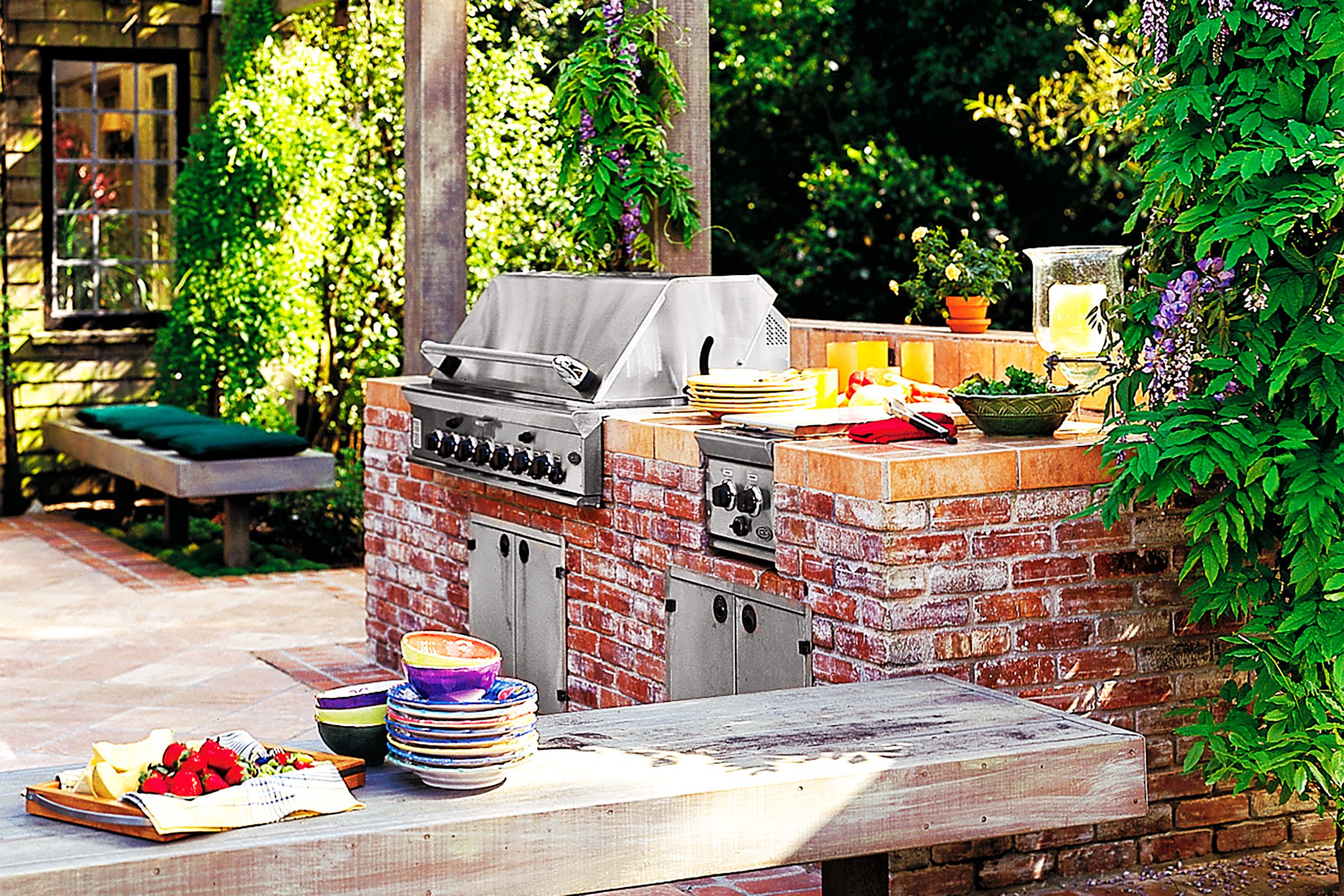
A masonry base in the form of mortared brick and stone is classic. To tie it in with the house, choose a material and design, such as the running-bond brick pattern pictured above, that echoes your foundation walls or chimney.
Contemporary
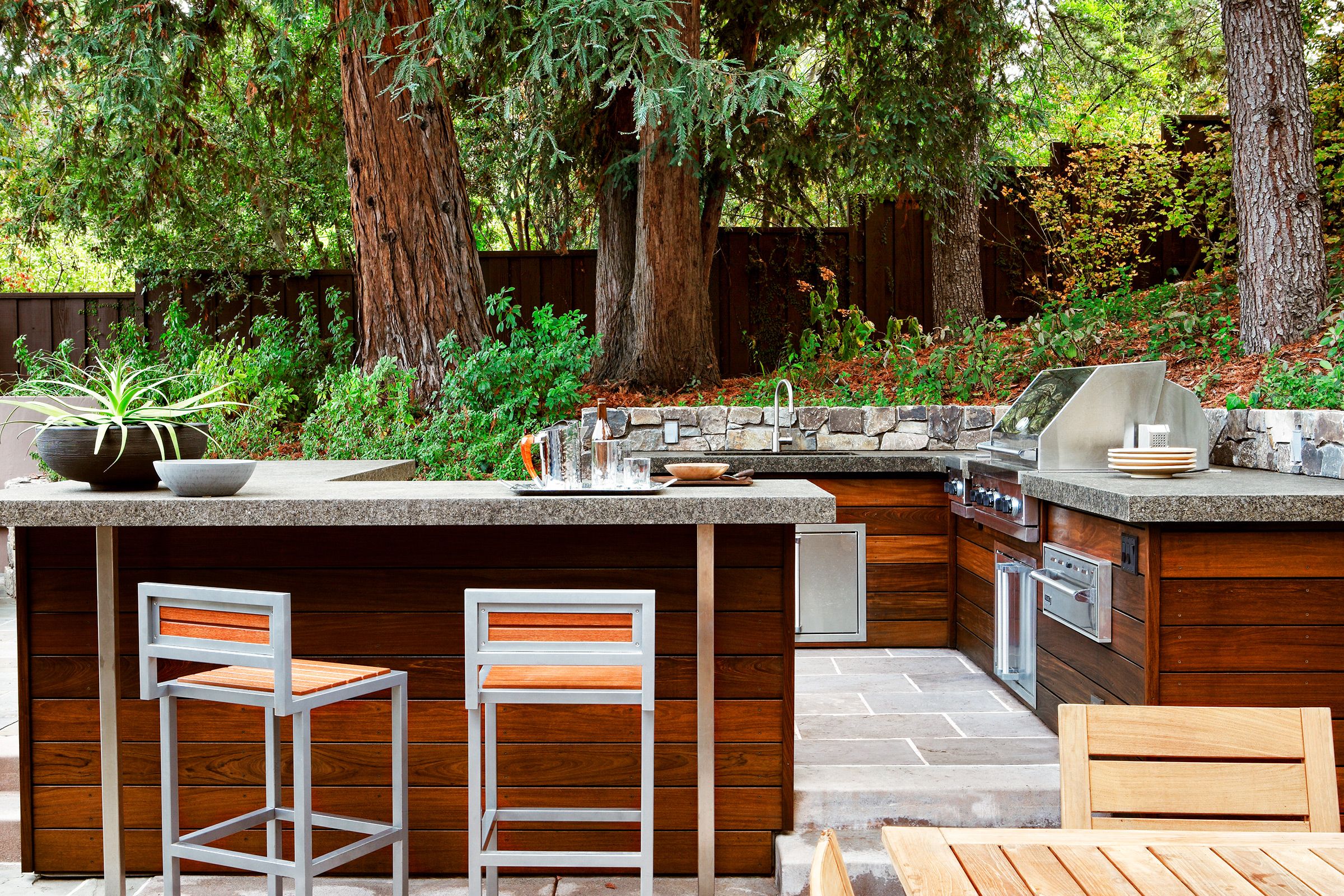
A contemporary style is characterized by sleek lines and polished finishes, such as granite and stainless steel. Here, ipe boards running in horizontal bands give dimension to the kitchen while also blending it with the wooded backdrop.
Rustic
Texture and matte finishes impart a lived-in look. For example, you could feature stucco on a built-in base that’s tinted to mimic terra-cotta, and to harmonize with the tones of a rough-stone counter. Earthy colors will blend with your surrounding plantings.
Related: More Outdoor Kitchen Ideas
2. Choose a Location Close to the House
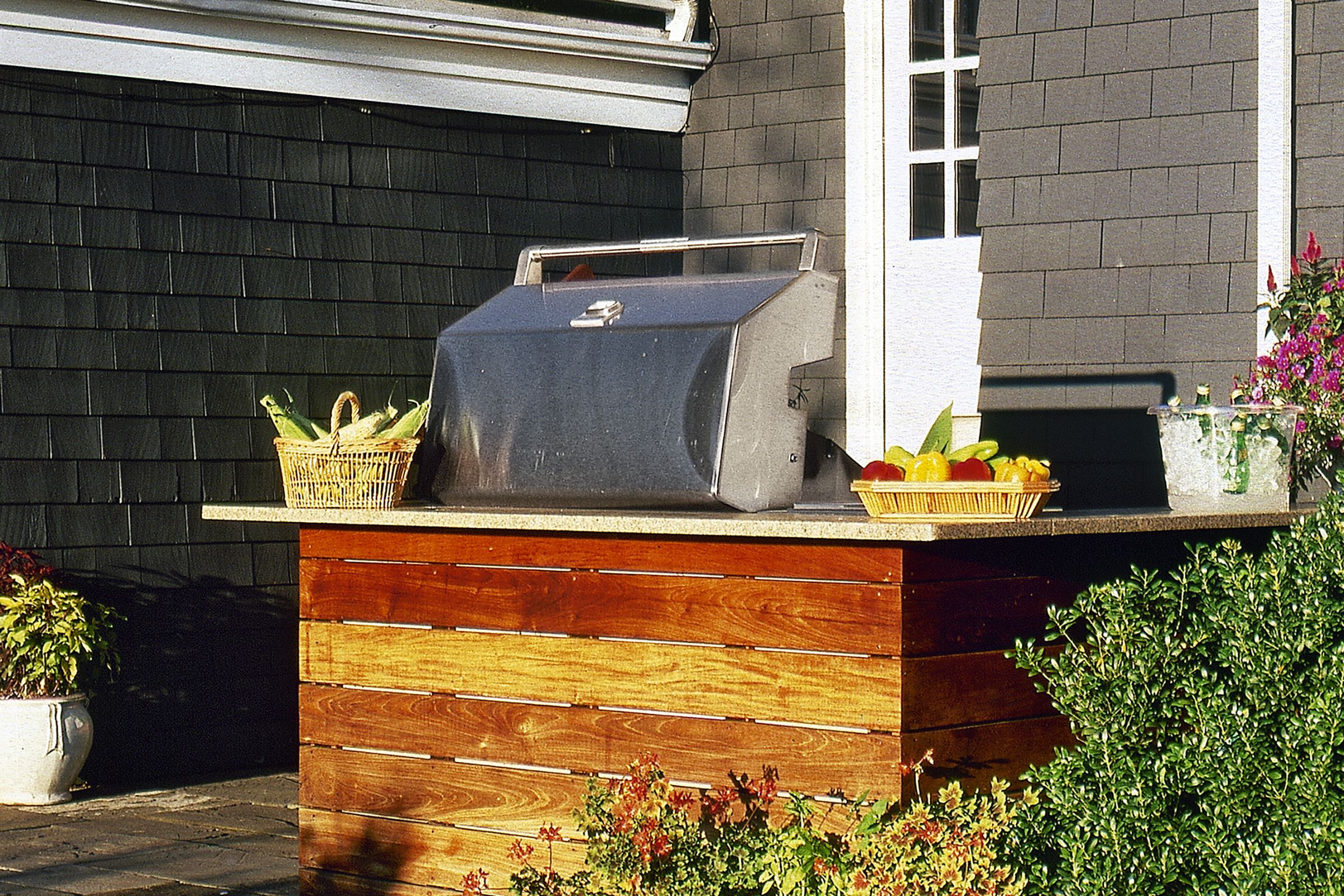
The side of the house can be an ideal location for an outdoor kitchen. There’s no need to excavate trenches for gas and electricity lines, and the house itself provides some shelter for the appliances. And when yard space is at a premium, an open space along the wall of the house might be the only spot available for a permanent kitchen.
Here are three reasons to build your outdoor kitchen close to your home:
- Convenience: You won’t have to haul food and supplies across the lawn. An ideal location is 15 to 20 feet from your indoor kitchen. Stay cool by placing seating in a shady spot, like under trees, an umbrella, or an awning.
- Budget: It’s less expensive to run utilities a short distance from the house. You can also save on paving by building on an existing patio or deck by the back door.
- Shelter: The walls of the house can provide structure and protection—at no extra cost. If under an overhang, avoid the smokehouse effect by placing the grill near the roof’s perimeter.
3. Pick Your Building Materials

Material Options for a Built-in Base
- Cultured-stone veneer: Mortared to a wood, concrete-block, or precast-concrete frame, cultured-stone veneer looks like and lasts as long as natural stone but is simpler to DIY because it’s lightweight and easy to cut.
- Brick: Brick is affordable and a cinch to maintain. Building with brick requires careful prep, and you may have to cut bricks to fit. However, if you’ve got basic masonry skills, it’s a good weekend project.
- Stucco: Troweled onto a wood, concrete-block, or precast-concrete frame, stucco has a hard-wearing and flameproof finish that’s available in a range of colors.
Material Options for Cabinetry
- Stainless steel: Durable and weatherproof and matches the grill
- Marine-grade polymer: Has the charm of painted wood, but won’t rot and is maintenance-free—just hose it down to clean it
- Teak: Offers a warm, classic look, but must be finished annually with a clear sealer
Material Options for Countertops
- Granite: Stands up to the elements, won’t stain as easily as marble, soapstone, or slate, and shouldn’t fade in the sun
- Concrete: Concrete countertops lend a clean, contemporary look but can be prone to cracking if not properly installed—they’re not DIY-friendly, and must be sealed and resealed annually
- Outdoor-rated ceramic tile: Thrifty, good for DIYers, offers a range of styles and colors, and best in regions where freezing and thawing won’t damage grout lines
4. Consider Adding Some Nice-To-Have Extras
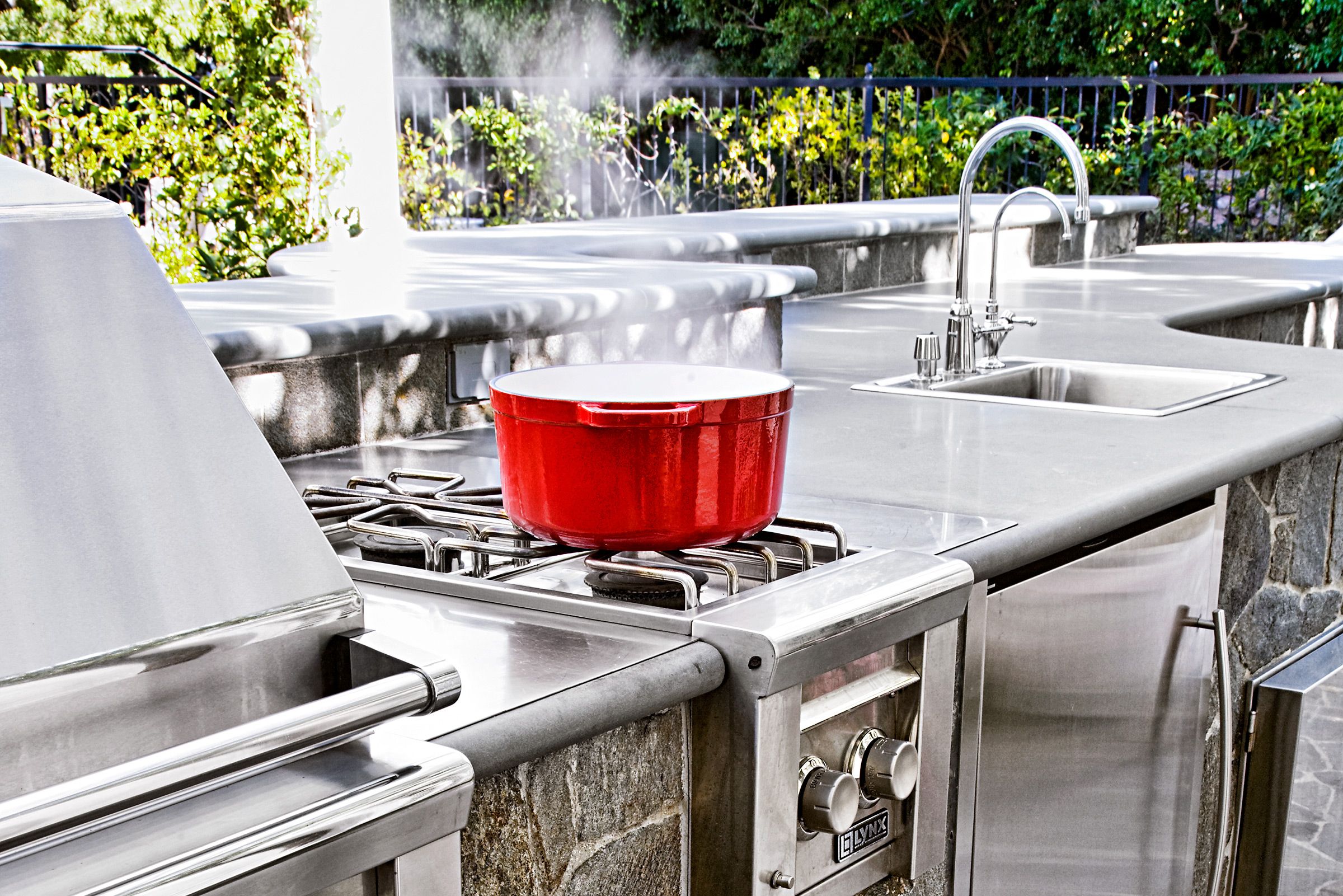
They’re not necessities, but these basics may make it easier to entertain:
- Sink: The ease and sanitary benefit of washing hands and veggies without traveling inside makes it worth the investment
- Dedicated gas line: If you have natural gas, run a line from the house so you don’t have to struggle with a propane tank or run out of fuel during a BBQ
- Extra burner: Ideal for side dishes—some grills come with one
- Refrigerator: A stainless-steel undercounter unit keeps cold drinks and ingredients within reach of the grill
More Add-Ons to Consider:
- Deep fryer: Large capacity handles finger foods and the Thanksgiving bird
- Kegerator: A keg on wheels that moves the party right to the grill
- Tripod-style burner: High firepower is ideal for boils in deep pots
- Pizza oven: Authentic wood-fired dome serves up a rustic slice
- Smoker: Propane provides the heat and wood chips make the smoke
- Ice maker: A no-plumb chiller relies on a water reservoir to make cubes
- Portable heater: Stay warm and extend the BBQ season with a propane unit, preferably on wheels
- Fold-up bench: Storage shelves, a lattice back for hanging utensils, and ample counter space make a collapsible bench an ideal bar or serving station
- Dual-use fan: Keep skeeters at bay while the breeze and built-in misters keep you cool
- Rolling cooler: Supplement a fridge or forgo one entirely with a cooler that wheels up to the grill, then locks in place
- No-plumb sink: A wall-mount vessel can hook up to a hose to create a cold-water washing station—divert wastewater to garden beds with a second hose
5. Add Coverage
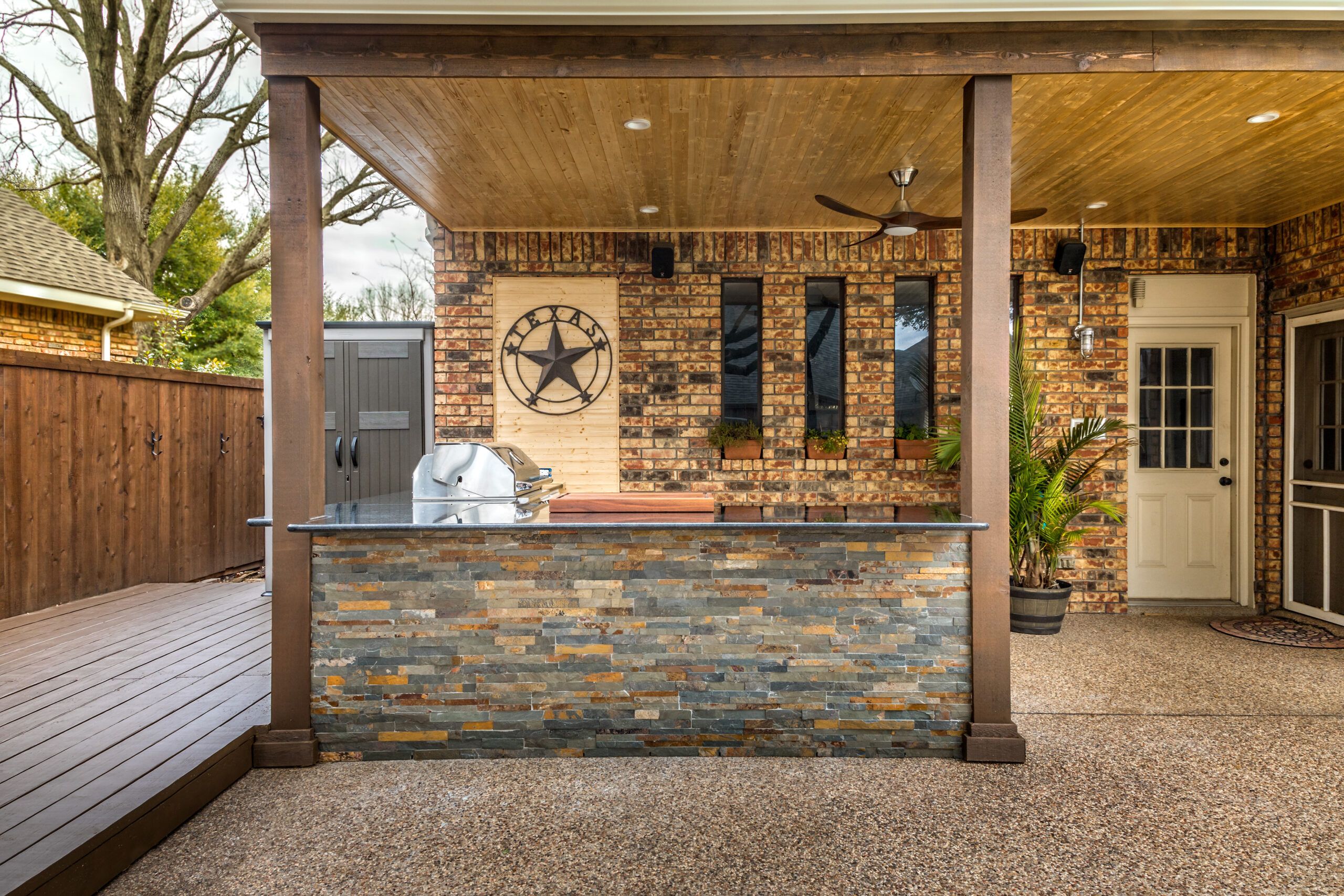
If your yard doesn’t get a lot of tree shade, you may want to add a roof over your outdoor dining space. We’ve listed a few options and their price points below so that you can choose the best one for your lifestyle and budget:
Pergola
A pergola is an outdoor structure made of wood, plastic, or metal. Columns support the roof and rafters. A slatted or lattice roof offers ventilation, but for more coverage, top with clear acrylic or galvanized metal. The average cost to build a pergola is $4,223.*
Awning
An awning is a covering that extends from an external wall of your house. Awnings are often made of either fabric or aluminum, and you can opt to make it retractable if you don’t want it to cover your space permanently. Awnings cost on average $3,004, but you can find basic options starting at $400.
Umbrella
For a movable kitchen, you can find an outdoor umbrella at a home improvement store or online. This covering is the least expensive and offers a multitude of design options. Look for one that’s sturdy and easy to move.
*Cost data in this section sourced from Angi.
6. Determine Your Dining Set-up
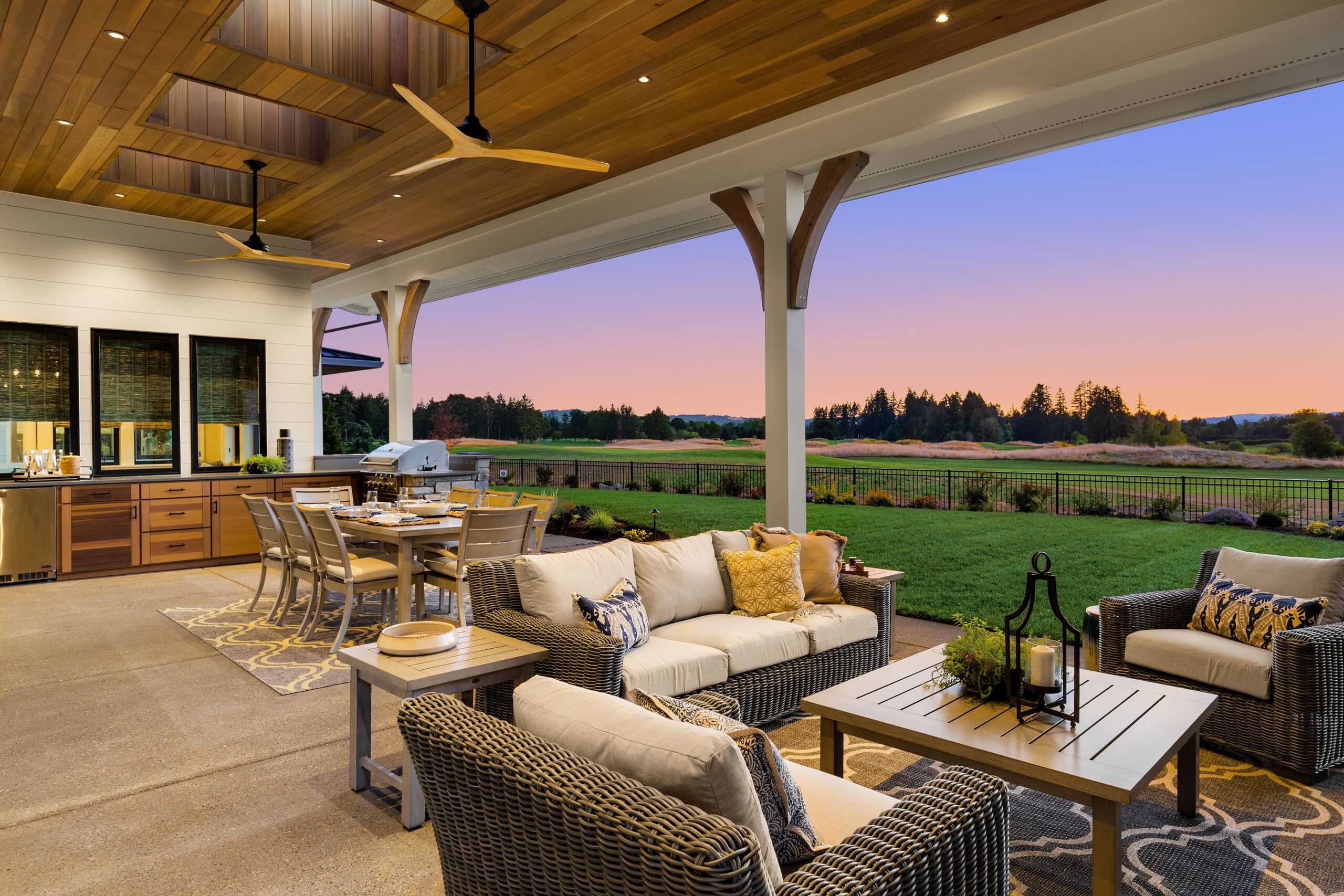
Alongside the decor and style, your seating arrangement impacts the flow and tone of your outdoor kitchen space. Below is an overview to the different ways you can set up the dining area:
- Family gatherings: Plan seating for six to eight around a table that’s about 96 inches long. Ideally, allow 42 inches between the edge of the table and a wall or other obstruction so that there’s room to push back chairs and walk behind those who are seated.
- Intimate meals: A bistro set offers space-saving and portable lightweight seating for two, while a 42-inch round or square table provides enough elbow room for four.
- Entertaining with friends: Just as guests congregate in the indoor kitchen, they’ll gather around the grill outside. Give them a place to perch—and keep them out of the cooking zone—with a freestanding pub table and stools. For built-in kitchens with a peninsula or for grill islands, add a breakfast-bar-style overhang that’s 15 inches deep for a 36-inch high counter, or 12 inches for a 42-inch one, to allow enough space for knees.
7. Make a Lighting Plan

Provide task lighting, such as a clip-on grill light or a standing lamp, for cooking and work areas. Ambient illumination at seating areas, in the form of all-weather string lights or rechargeable LED tea lights, will set the mood. And, for safety, consider small spotlights or solar-powered stakes along paths leading to your open-air kitchen, riser lights for deck stairs, and an overhead lantern where you enter the house.
8. Have a Winterizing Plan
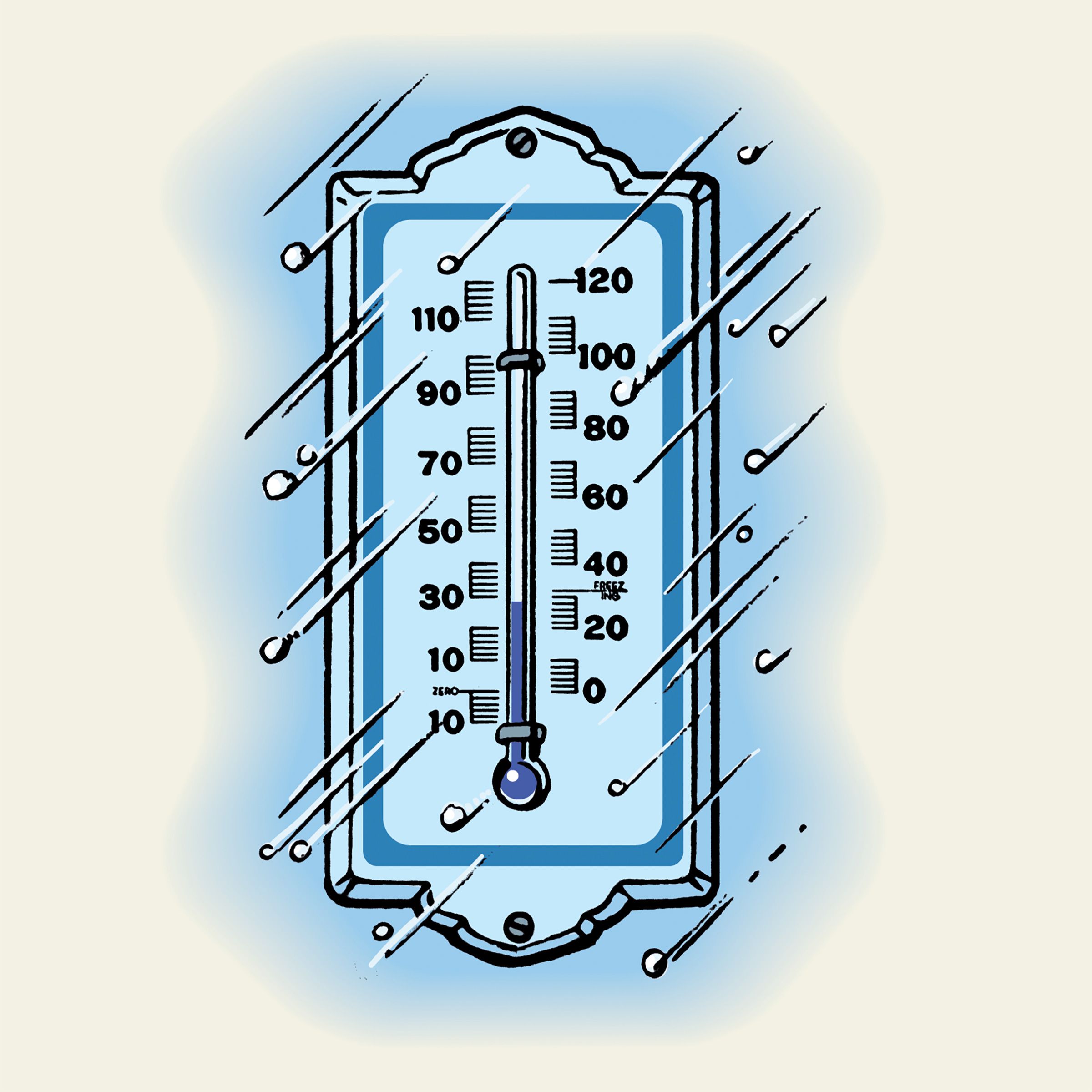
When temperatures get near freezing, you may need to close up shop for the winter. Here’s how:
- Clean and cover the grill.
- Turn off and unplug all other appliances, such as a fridge.
- Shut off the water supply, and flush any remaining water from the pipes. This is easiest if your plumber installs a gravity-based winterization system—otherwise, you’ll have to pump the water out.
Our Conclusion
Building an outdoor kitchen extends your living space and provides you with the ease of entertaining outside. After determining your budget, you can decide whether to build a custom, prefab, or moveable kitchen. From there, you can pick out materials, roof coverage, and lighting. We recommend choosing a location close to your house so it’s easier to connect to gas, electric, and water lines, and remember to take the proper safety precautions to avoid fires. Installing a kitchen in your yard will help you create an outdoor oasis to enjoy for years to come.
